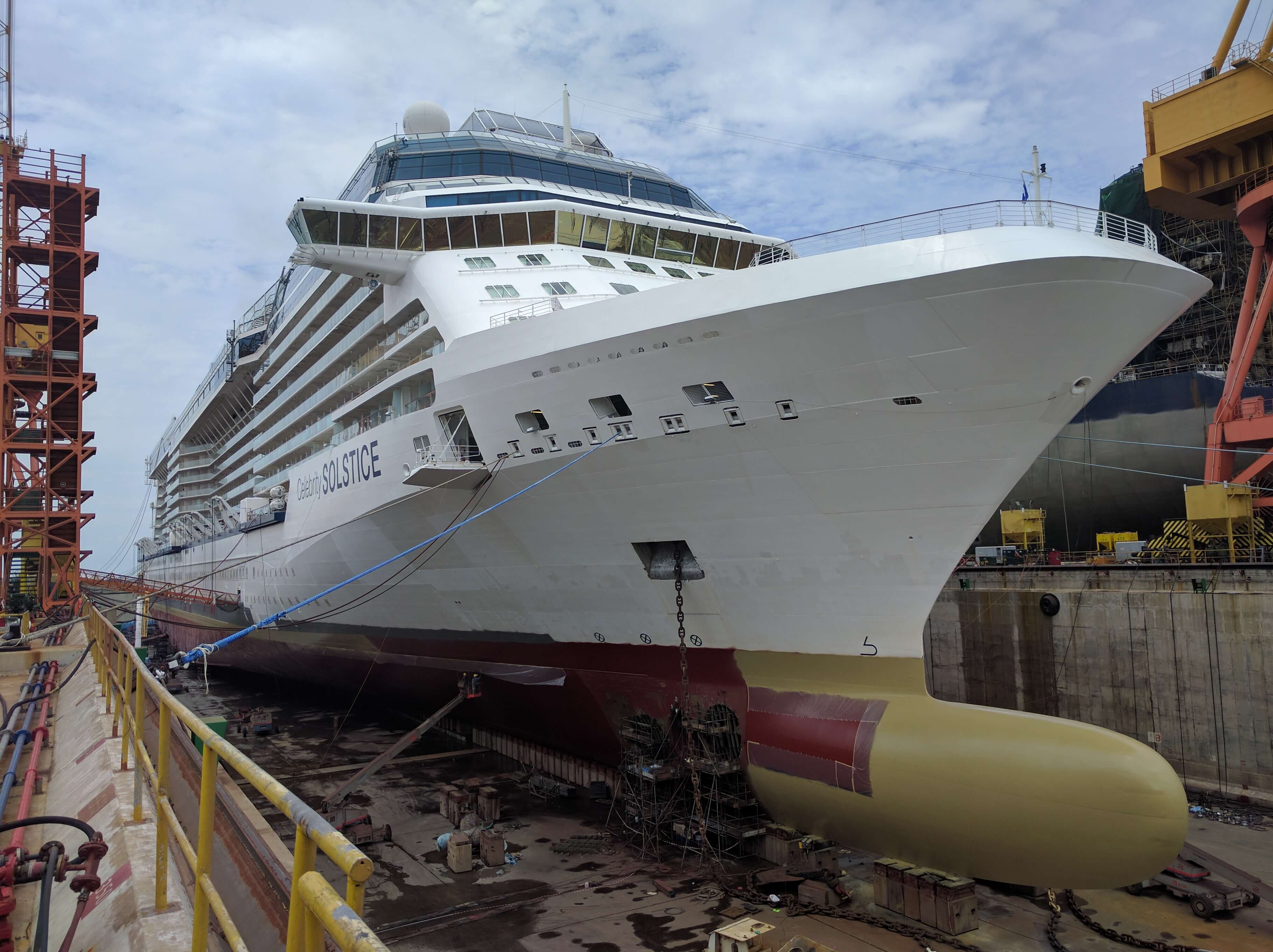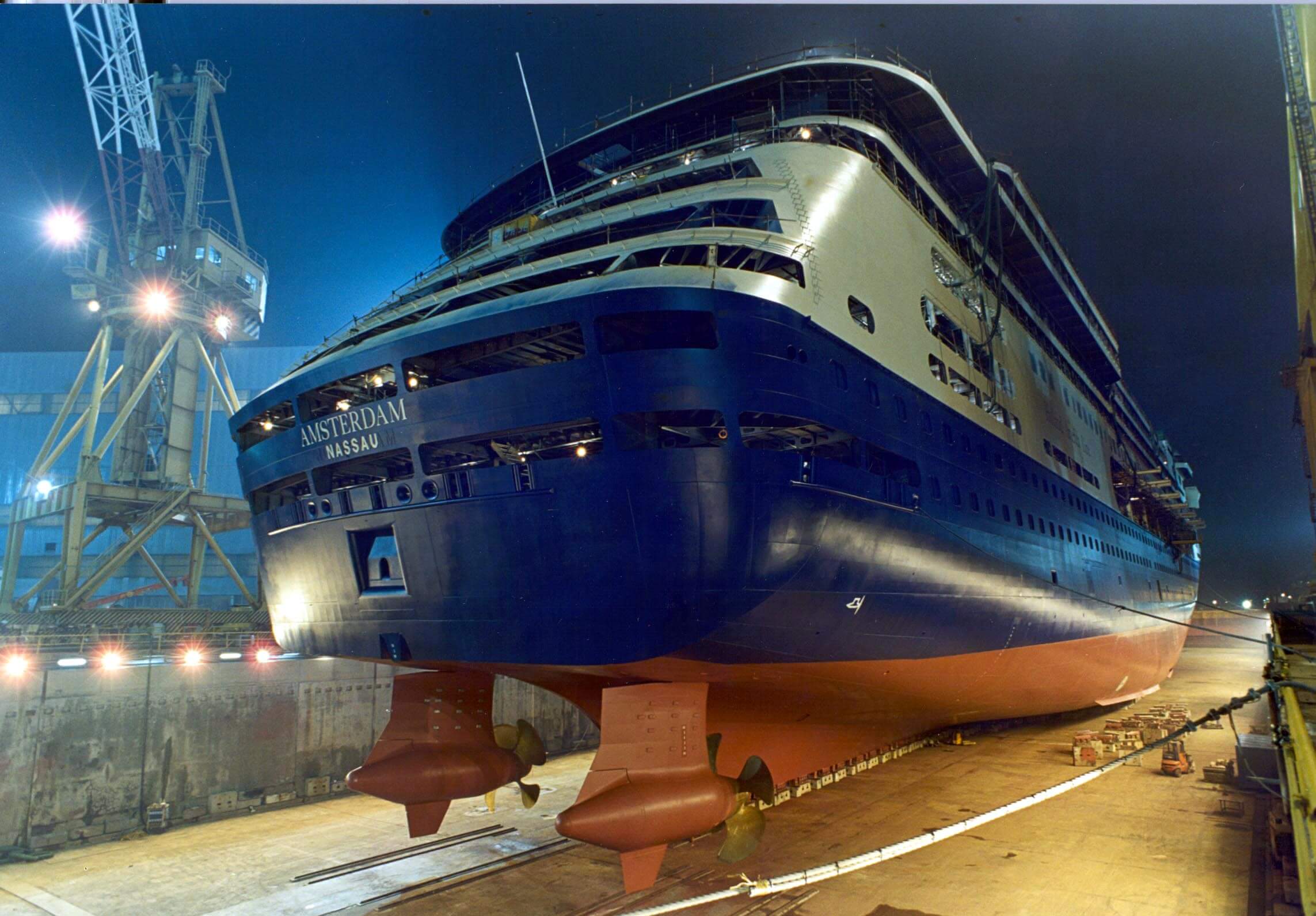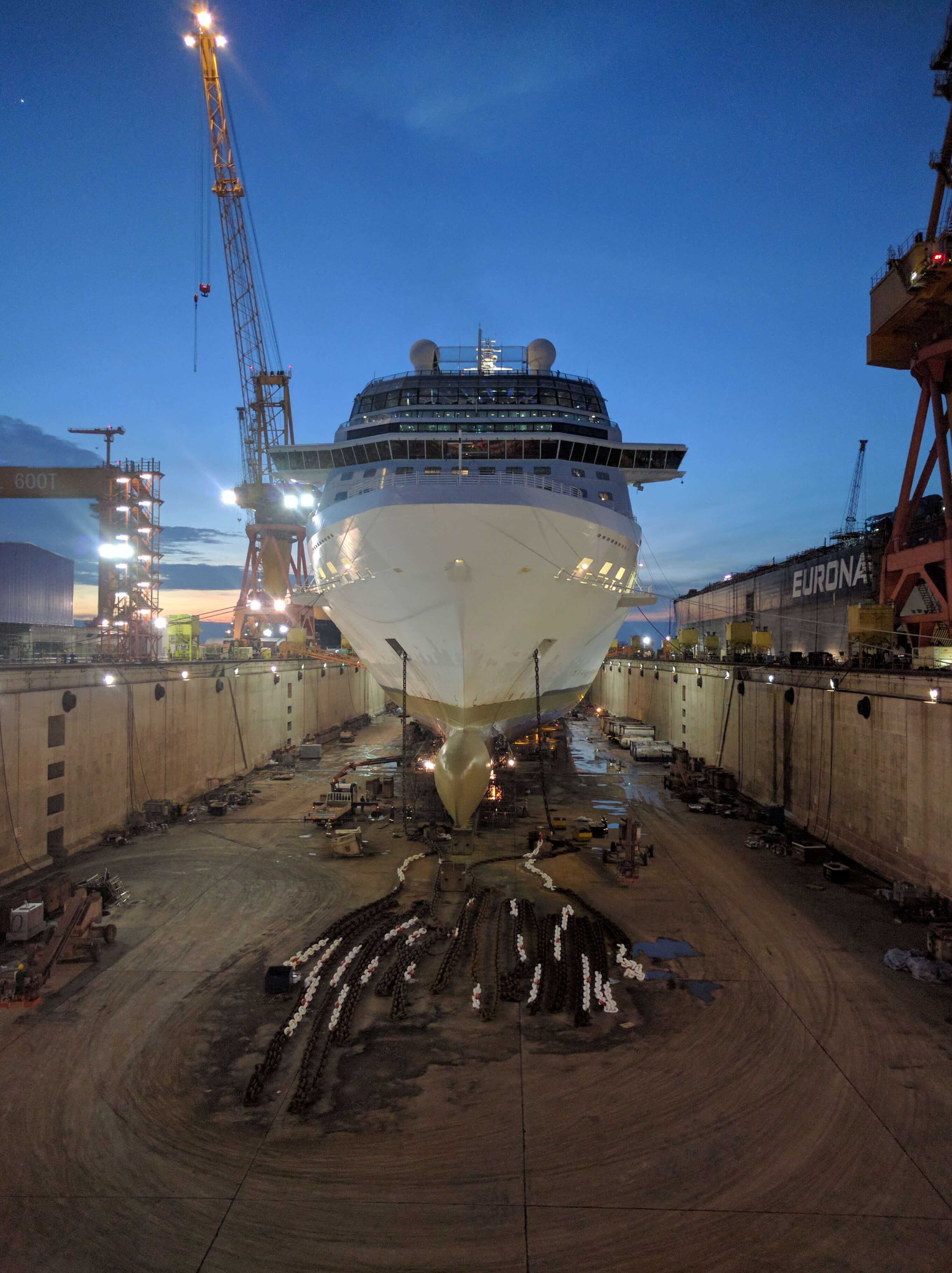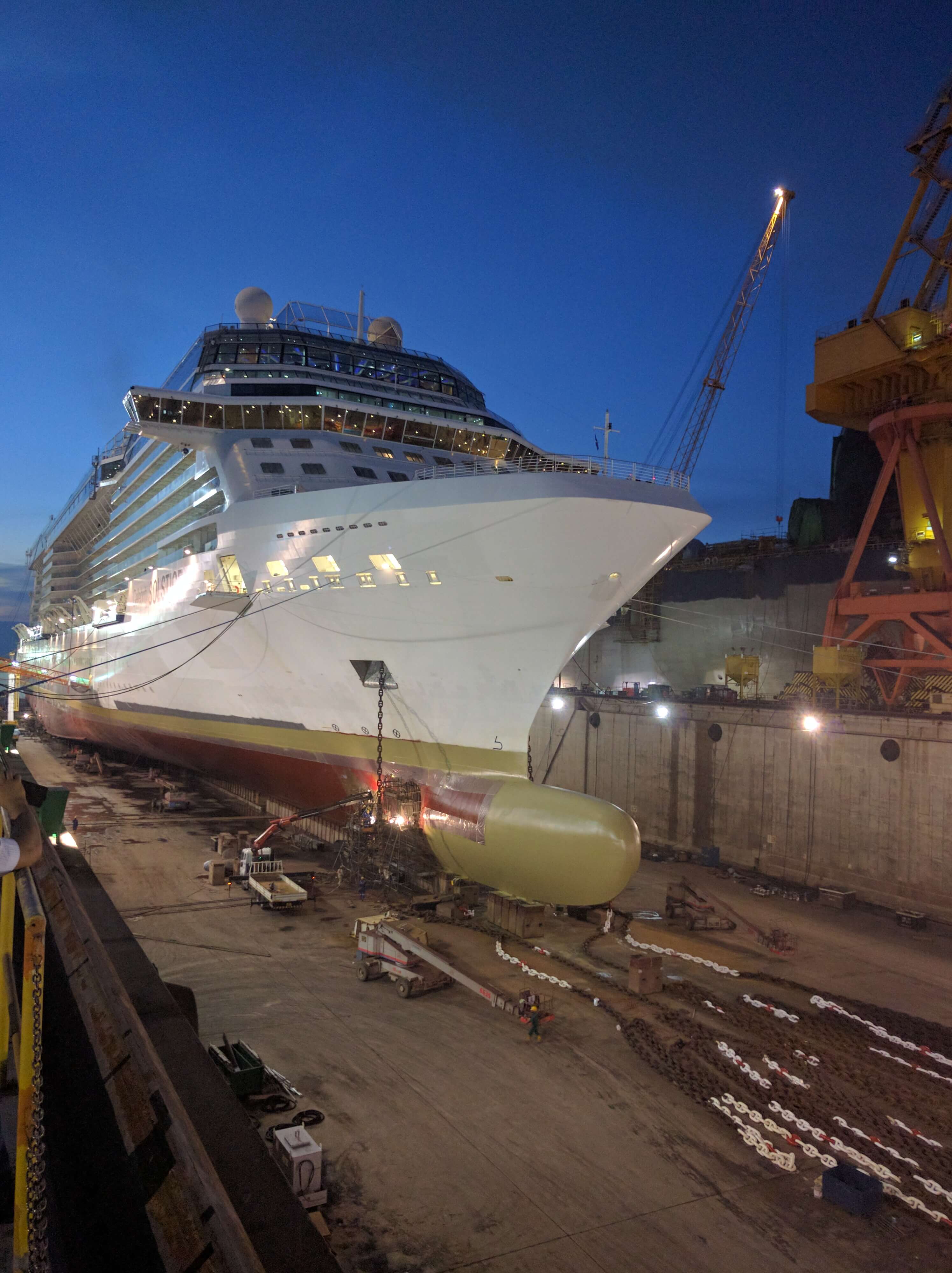The bottom of a cruise ship might not be the first thing that comes to mind when you think of a luxurious cruise journey, but it is undeniably one of the most vital components of maritime design and engineering.

As you stand aboard a grand cruise ship, captivated by its opulent amenities and the vast seascape, it’s easy to forget the marvel that lies submerged beneath the waterline.
This crucial part of the ship, often overshadowed by its above-deck counterparts, plays a foundational role in ensuring performance, safety, and sustainability.
Delving into the intricacies of a cruise ship’s underside offers insights into the world of naval architecture, dispelling myths and revealing the innovations that guarantee our voyages are not only enjoyable but also safe.
Let’s embark on a deep dive into the unseen hero that keeps these magnificent vessels afloat.
What Is the Bottom of a Cruise Ship Called?
For those unfamiliar with naval terminology, deciphering the various parts of a ship can seem like navigating through a linguistic maze.
When it comes to cruise ships, or any seafaring vessel, the ‘bottom’ has its own special designation, deeply entrenched in shipbuilding traditions and maritime lore.
The bottom of a cruise ship is commonly referred to as the “hull.” The hull is the watertight body of the ship, extending from the main deck to the very base.
It is integral to buoyancy, stability, and the overall structural framework of the vessel.
Built to counteract water pressure, stave off corrosion, and facilitate smooth sailing, the hull’s design and materials are specifically tailored for maritime conditions.
Within the hull, there are distinct subdivisions:
The Keel
Often regarded as the ship’s backbone, the keel runs centrally from the front to the back at the very bottom. It grants the ship its structural strength and is paramount for stability.
The Bilge
Situated at the lowest part of the ship’s hull, the bilge is where water typically accumulates due to various factors like condensation, potential leaks, or specific onboard activities.
Ships are equipped with bilge pumps designed to expel this water, ensuring the vessel remains dry and secure.
A protrusion at the front bottom of many modern ships, including cruise ships. This unique design helps reduce resistance as the ship moves through water, increasing fuel efficiency and speed.
It also aids in reducing the bow waves, making voyages smoother for passengers.
Over the centuries, the design and nuances of the hull have continually evolved, reflecting advancements in technology and the distinct requirements of diverse ship categories.
In the context of cruise ships, the hull stands out as especially vital, safeguarding the journey of thousands of passengers and crew members as they traverse the vast oceans.
To sum up, while the phrase ‘bottom of a ship’ may sound elementary, it unfolds a universe of design, engineering, and maritime heritage in the embodiment of the hull. It showcases mankind’s remarkable capacity to innovate and master the challenges of the deep blue.
What Does the Bottom of Cruise Ships Look Like?
The exterior of cruise ships, with their towering decks and panoramic windows, often captures the imagination of spectators. Yet, the underwater portion, though unseen by most passengers, is an engineering marvel in its own right.

Image credit: Bolici
So, what does it look like underneath a cruise ship?
Shape and Structure
The underbelly of a cruise ship is streamlined and sleek, designed for efficient movement through water. While the top of the ship might have multiple decks and superstructures, the bottom narrows down to a smooth, somewhat flat surface, tapering towards the stern and bow.
Material and Color
Typically made of robust steel, the hull has a thickness that can handle the immense pressures of the sea. It is often coated with a specialized paint known as anti-fouling paint.
This unique paint, usually dark in color (like blue or black), prevents marine organisms like barnacles and algae from attaching to the ship, ensuring smoother movement and better fuel efficiency.
Bulbous Bow
As previously mentioned, many modern cruise ships have a bulbous protrusion at the front bottom. This rounded extension is easily identifiable and plays a pivotal role in enhancing the ship’s hydrodynamics.
Rudders and Propellers
Towards the stern of the ship, one can find the ship’s rudders and propellers. These critical components steer the ship and provide thrust, respectively. They are massive in size, with some cruise ship propellers spanning several meters in diameter.
Stabilizers
Extending from the sides of the hull are stabilizer fins, similar in appearance to airplane wings but submerged. They help counteract the ship’s roll, ensuring a more stable and comfortable journey for passengers.
Sensors and Equipment
The hull might house various sensors, like sonar, which assist in navigation and detecting underwater obstacles. These devices are often recessed or streamlined to maintain the smooth contour of the ship’s underside.
Keel and Bilge
Right at the center and deepest part of the bottom, the keel runs longitudinally, acting as the ship’s backbone. The bilge, a slightly curved section, is where water collects and is expelled by bilge pumps.
In essence, the bottom of a cruise ship is a fusion of form and function, showcasing advanced engineering tailored for the unique demands of maritime travel.
It’s an intricate balance of design elements, all working in harmony to navigate the complexities of the ocean and provide passengers with unforgettable voyages.
How Far Underwater Is The Bottom Of A Cruise Ship?
One of the marvels of maritime engineering is the ability to float structures weighing several tons effortlessly on water. Cruise ships, often referred to as “floating cities” due to their vastness, are a prime example.

But just how deep does the bottom of such a vessel sit underwater? This submerged portion of the ship is technically termed its “draft.” Here’s an exploration of that aspect
Understanding Draft
The draft of a ship refers to the vertical distance between the waterline and the lowest point of the vessel’s keel. In simple terms, it indicates how much of the ship is underwater
Factors Influencing the Draft
Ship’s Load
As a ship takes on more weight, be it cargo, fuel, provisions, or passengers, it will sit deeper in the water, increasing its draft.
Water Density
Saltwater is denser than freshwater. So, a ship will sit slightly higher (have a shallower draft) in the ocean compared to a freshwater lake or river, all else being equal.
Temperature and Salinity
Variations in water temperature and salinity can influence its density, subsequently affecting the ship’s draft.
Typical Draft of a Cruise Ship
Cruise ships vary in size, from smaller luxury vessels to mega-ships. The draft can range considerably based on this:
Smaller Cruise Ships
They might have a draft ranging from 20 to 25 feet (6 to 7.6 meters).
Medium to Large Cruise Ships
These can have drafts anywhere from 25 to 30 feet (7.6 to 9.1 meters).
Mega Cruise Ships
The largest of cruise ships can have drafts exceeding 30 feet (9.1 meters), with some even approaching 40 feet (12.2 meters).
Operational Considerations
Navigating Shallow Waters
Cruise ships sometimes need to access ports located in shallower waters. In such cases, having a shallower draft is beneficial. Some ships are specially designed with this in mind to expand their potential itineraries.
Ballast Systems
Modern cruise ships are equipped with ballast systems that can adjust the amount of water they carry, thereby influencing their draft to some degree, helping in optimizing stability and navigating varying water depths.
Safety Margins
While understanding the draft is essential for navigation, ships also maintain safety margins. This ensures that they don’t accidentally scrape the seabed when navigating areas close to their maximum draft.
In essence, the portion of a cruise ship that’s submerged underwater is influenced by a variety of factors, both inherent to the ship’s design and external conditions.
While passengers aboard enjoy the panoramic views and luxurious amenities, the depth at which the ship’s bottom sits plays a pivotal role in its safe and efficient navigation.
Are Cruise Ship Bottoms Flat?
The design and structure of cruise ships are fascinating topics of exploration, and a common question that arises is regarding the shape of their bottoms.

Are they flat, as one might presume when considering the massive size and weight of these vessels?
Let’s have a look:
General Design
At first glance, one might assume that the large, broad base of a cruise ship would be flat to maximize stability. However, the reality is more intricate.
Cruise ship bottoms are not entirely flat; they have a somewhat curved design, especially noticeable from the bow to the stern.
Why Not Completely Flat?
Several reasons dictate the non-flat design
Hydrodynamics
A completely flat bottom could create more resistance as the ship moves through the water. A slightly curved design allows for smoother passage, reducing drag and improving fuel efficiency.
Buoyancy and Stability
The curved design distributes the ship’s weight more evenly, allowing it to float and move with more balance, especially in rough seas.
Dealing with Depths
A slightly raised or curved design in certain parts of the bottom ensures the ship doesn’t run too deep, especially helpful when navigating shallower waters or ports.
Considerations in Modern Shipbuilding
As cruise ship designs evolve, so do the considerations for their hull shape. Environmental concerns, fuel efficiency, passenger comfort (minimizing motion sickness), and navigational needs all play roles in determining the precise curvature and features of a ship’s bottom.
Basically, while cruise ships might appear to have a vast, flat base given their immense size, their bottoms are not strictly flat.
They are designed with a subtle curvature and specific features that cater to the complex demands of maritime engineering, ensuring efficient, safe, and comfortable voyages for all on board.
Why is the Bottom of a Ship Painted Red?
The distinctive red color often seen painted on the bottom of ships, both historic and contemporary, is more than just an aesthetic choice.
This age-old tradition has a foundation in practicality, functionality, and maritime science. Here’s a closer look at why ships frequently don this fiery hue below the waterline:
Historical Use of Copper
In the age of wooden ships, sailors discovered that sheets of copper or copper-based paint on a ship’s hull would prevent marine organisms like barnacles and teredo worms from boring into the wood and damaging it. Copper, when in contact with seawater, releases ions that have anti-fouling properties.
The characteristic reddish-brown color of oxidized copper led to a distinct red hue on the ship’s bottom.
Anti-fouling Paint
Marine organisms attaching to the hull – known as fouling – significantly impact a ship’s performance and durability. It can increase drag, reduce speed, and lead to higher fuel consumption.
Modern anti-fouling paints, which are successors to the original copper sheathing method, often still contain cuprous compounds. While there are varying colors available today, the traditional red remains a popular choice due to its historic ties.
Visibility of Damage and Fouling
Red offers a stark contrast to the deep blues and greens of ocean waters. This contrast makes it easier for sailors and dock workers to spot damages, leaks, or excessive fouling on the ship’s hull.
Tradition and Aesthetics
Over time, the red bottom became a maritime tradition. Even with the evolution of marine paints and coatings, many ship owners and builders still prefer the classic red for its aesthetic appeal and nod to seafaring heritage.
Economical and Practical
Red pigments were historically more affordable and abundant, making them a cost-effective choice for shipbuilders and owners.
Variations in Hue
It’s worth noting that while red is common, it’s not universal. Different shades ranging from brownish-red to pink or even other colors like black and blue can sometimes be observed.
These choices can be influenced by the specific anti-fouling product used, company branding, or other functional considerations.
In summary, the red bottom of ships is a marriage of practicality and tradition. While it has its roots in the bygone era of wooden vessels and copper sheathing, the color persists today as a symbol of maritime legacy, aided by the practical benefits it continues to offer in the modern age.
How Do You Clean the Bottom of a Cruise Ship?
Ensuring the hull of a cruise ship is clean is not just an aesthetic concern; it’s crucial for the vessel’s efficiency, safety, and environmental footprint.
Over time, marine organisms, such as barnacles, algae, and mussels, can attach themselves to the ship’s bottom. This phenomenon, known as biofouling, can slow the ship down, increase fuel consumption, and even damage the hull.
So, how do cruise lines keep these gigantic vessels in pristine condition beneath the waterline?
Dry Docking
This is the most comprehensive method for cleaning and maintaining the hull. Every few years, cruise ships are scheduled for dry docking. During this process, the entire vessel is taken out of the water, allowing workers to access and clean the ship’s bottom thoroughly.
This is also an opportunity to inspect the hull for damages, repaint it with anti-fouling paint, and conduct any other necessary repairs or upgrades.
Underwater Cleaning Robots
With advancements in technology, some cruise lines employ automated underwater robots or remotely operated vehicles (ROVs) equipped with brushes and cameras.
These devices can scrub the hull’s surface while the ship is still in the water, removing accumulated organisms and grime.
Divers
For specific tasks, or when robots might not be feasible, trained divers are deployed. They manually clean and inspect the hull using specialized tools. This method is particularly useful for addressing localized issues or conducting minor repairs.
Anti-fouling Coatings
One preventive measure against biofouling is the application of anti-fouling paint. These coatings release biocides, substances that deter marine organisms from attaching to the hull.
The paint not only provides a smoother surface, reducing drag and enhancing fuel efficiency, but also minimizes the need for frequent cleanings.
Ultrasonic Systems
Some modern ships are equipped with ultrasonic anti-fouling systems. These use ultrasonic waves to prevent marine growth on the hull.
The vibrations create an environment that’s unfavorable for organisms, thereby preventing them from settling on the ship’s bottom
Eco-friendly Solutions
With growing environmental concerns, the maritime industry is continuously exploring eco-friendly solutions for hull cleaning. Techniques that don’t rely on harmful chemicals and that cause minimal disruption to marine ecosystems are being prioritized.
Maintaining the cleanliness of a cruise ship’s bottom is an ongoing task that combines manual efforts, technological solutions, and preventive measures.
The commitment to keeping these colossal vessels clean underscores the importance of efficiency, safety, and environmental responsibility in the cruise industry.
What is in the Bottom of a Cruise Ship?
While the vast decks and luxurious amenities are what usually capture the attention of cruise-goers, the bottom levels, often hidden from the guests’ view, play a pivotal role in ensuring the smooth operation of the entire vessel.
These areas, which make up the foundational layers of the ship, are both functional and crucial for safety. So, what exactly can one find in the bottom of a cruise ship?
Engine Rooms
Typically situated deep within the ship, the engine rooms house the primary machinery that powers the cruise ship. From massive diesel engines to electrical systems, this is where the ship’s heartbeat resides.
Fuel Tanks
Large tanks containing the fuel needed to power the ship’s engines are usually located towards the bottom. Their placement helps in maintaining the ship’s balance and stability.
Ballast Tanks
Ballast tanks play a vital role in maintaining a ship’s stability. They can be filled or emptied of water to adjust the ship’s weight and balance. This is particularly useful when accommodating changes in fuel weight or cargo distribution.
Bilge Area
As mentioned earlier, the bilge is the lowest point of the ship where water, from sources like condensation or minor leaks, collects. Bilge pumps are stationed here to expel this water and ensure the ship remains dry.
Stabilizers’ Machinery
While the actual stabilizers are external and protrude from the sides of the ship, the mechanisms and controls that operate them are located within the lower levels.
Waste Treatment Facilities
Modern cruise ships are equipped with advanced waste treatment systems that handle and process sewage, gray water, and other waste products. This ensures environmental regulations are met and minimizes pollution.
Storage Areas
The bottom levels often contain vast storage rooms. These are crucial for storing provisions, from food and drink to spare parts and other essential supplies needed for long voyages
Crew Quarters
While crew members reside throughout the ship, some crew quarters, especially for those working in the engine rooms or other lower-deck service areas, might be located towards the ship’s bottom.
Laundry Facilities
Given the number of guests and the volume of linens, towels, and uniforms, cruise ships require extensive laundry facilities. Some of these operations are located in the lower decks due to space requirements and logistical convenience.
Water Tight Compartments
For safety, the bottom of the ship contains several watertight compartments. In the event of a breach or flooding, these compartments can be sealed off to prevent water from spreading and compromising the ship’s buoyancy and stability.
In essence, the bottom of a cruise ship is a bustling hub of crucial operations and facilities, all working seamlessly behind the scenes.
These layers ensure that guests above can enjoy their journey with peace of mind, blissfully unaware of the intricate dance of engineering and logistics taking place below their feet.
Videos Underneath a Cruise Ship
Here’s an interesting video of a guy dropping a gopro underneath a cruise ship…
And here’s a video of a cruise ship in drydock:
To Sum It Up
The bottom of a cruise ship, often overshadowed by the vessel’s towering decks and luxurious amenities, holds a rich tapestry of engineering, history, and maritime tradition.
From the precise design of the hull to ensure hydrodynamic efficiency and stability, to the depths at which these massive ships sit in the water, and the distinctive red hue that has colored the undersides of vessels for centuries, each aspect serves a purpose rooted in functionality and heritage
. The red paint, in particular, is a vivid testament to the blending of past maritime practices with contemporary needs, symbolizing the enduring spirit of naval exploration and adventure.
As passengers sail to their next destination, they’re buoyed by a legacy of seafaring innovation and tradition that lies beneath them, ensuring every voyage is safe, efficient, and in harmony with the vast oceans that cradle these magnificent vessels.


